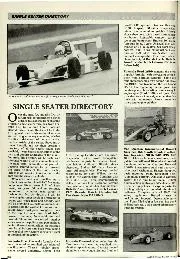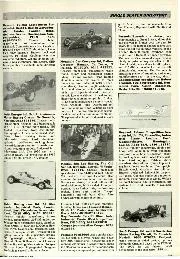

SINGLE SEATER DIRECTORY
SINGLE SEATER DIRECTORY Over the next few months MOTOR SPORT will be presenting a series of track tests of cars from all of the principle single seater formulas, from Formula…

Grand Prix Photo
The author had no intention of writing this new biography of Niki Lauda. After all, the three-time World Champion’s wonderful story has been told often and well through the decades in magazines, books and on film. But when Lauda died on May 20 last year at the age of 70, Maurice Hamilton found himself compelled to revisit the life of a man he had known for 40 years, such was the outpouring of genuine grief, including from within the modern-day Formula 1 paddock, in which Niki remained both actively relevant and hugely popular.
On the anniversary of his death, this isn’t the only Lauda book hitting the shelves this month. His celebrated autobiography To Hell and Back is also back in circulation, with the addition of a new introduction and a round-up chapter on his later years by former Times motor racing correspondent Kevin Eason. But Hamilton’s book, which has the blessing of Lauda’s sons, Lukas and Mathias, is the one we’d recommend. As great as To Hell and Back remains, the new biography adds greater detail from other perspectives while still drawing on the best direct quotes from the many other interviews Lauda gave over the years. Autobiographies are not necessarily the definitive word on a subject.
Hamilton adds a nice personal touch, given that he had so many dealings with Lauda from their first interview in 1982. He includes a delightful portrait he took as a fan, of a young Niki in his Formula 2 March at Mallory Park in 1971. Lauda was never one for nostalgia, but years later when Hamilton showed him the picture he was genuinely moved, especially when he spotted the family ring on his left hand. The heirloom would soon be discarded, following the traumatic row with his autocratic grandfather, who had tried to sabotage his racing ambitions.
The two-part career through the 1970s and ’80s will be familiar for most, but the author’s deft touch keeps a brisk pace and his use of less familiar period interviews adds vivid colour, detail and Lauda’s own unmistakable, clipped voice. Perhaps it’s Hamilton’s newspaper background that draws him to Fleet Street sources, such as David Benson’s period interviews with Lauda for The Daily Express on the Nürburgring 1976 crash and his remarkable return at Monza. Lauda’s matter-of-fact description of the mortal battle he fought in the days after the accident still sends a shiver.
But what really makes this new biography compelling are the chapters after 1985. Writing about Niki Lauda is like revisiting The Beatles: you think it’s all been told before. The trick is to unearth the nuggets that offer new depth and perspective. That’s not easy for Lauda’s racing career – although Hamilton gives it a good go – but the approach comes into its own when documenting Niki’s dual careers running his airline and other people’s F1 teams, perhaps because these years are less documented.
The chapter on the crash in 1991 that claimed the lives of all 223 onboard Lauda Air’s Boeing 767 is particularly affecting and thorough – as you’d expect on such a topic. Lauda’s pursuit of Boeing for the truth about its cause and his heartfelt promise to the grieving families to find them the answers is at least as powerful as anything in the sections on the 1976 season. The scars from the “worst experience of [his] life” ran deeper than those on his face and head.
Lauda’s time as a consultant at Ferrari during the 1990s, when he was charged by his old friend Luca di Montezemolo to revive the team’s fortunes, doesn’t dwell on the details of his failure, but instead gives credit for his anointment of Jean Todt as the man to complete the task. That recommendation cost him his job, as Todt eventually pushed him aside – but Lauda never bitched: it wasn’t his way. Anyway, his instincts had been on the money. Todt went on to work wonders that were probably beyond Lauda’s political capabilities.
The section on Jaguar and Lauda’s part in its sorry F1 debacle at the turn of the century are more revealing, particularly the accounts of his dealings with Ford’s hopeless corporate executives. Richard Parry-Jones is a revered figure in the wider automotive world, but he never did understand motor racing. Lauda was miscast in his role asthe head of the pompously titled ‘Premier Performance Division’, but again his instincts were proven right. He introduced Dietrich Mateschitz and Red Bull to the board as a potential sponsor, a notion dismissed out of hand. But the energy drinks company would prove rather more competent at running the F1 team than the shiny suits Lauda had to deal with.
The most illuminating part is the section on Lauda’s role within the hugely successful Mercedes F1 team. His influence went far beyond just convincing Lewis Hamilton to step away from McLaren in 2012. The author’s interviews with team boss Toto Wolff reveal a depth of friendship that is as genuine as it is surprising. These were very different men, and at times Wolff’s patience was sorely tested by the blunt force of his non-executive chairman. But Lauda’s trademark antipathy for “bullshit” added a vital element of authenticity to the Mercedes mix.
For a man known as ‘The Computer’ during his driving career, it was Niki Lauda’s humanity that was his true driving characteristic, and that’s the running thread that pulls his authoritative book together. No wonder we miss him so much.